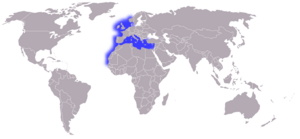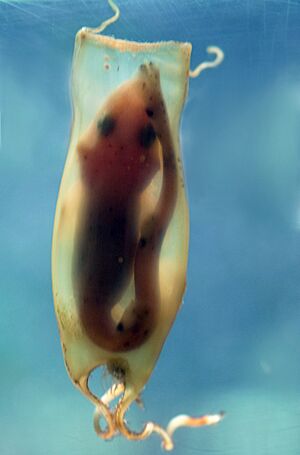Small-spotted catshark facts for kids
Quick facts for kids Small-spotted catshark |
|
|---|---|
 |
|
| Conservation status | |
| Scientific classification | |
| Genus: |
Scyliorhinus
|
| Species: |
canicula
|
 |
|
| Range in blue | |
The small-spotted catshark (Scyliorhinus canicula) is a type of catshark. People also call it the sandy dogfish, lesser-spotted dogfish, rough-hound, or morgay. It belongs to the family called Scyliorhinidae.
You can find these sharks in the waters off Norway and the British Isles, stretching south to Senegal. They also live in the Mediterranean Sea. They prefer the areas near continents, called continental shelves, and the very top parts of the continental slopes.
These sharks can grow up to about 1 meter (3.3 feet) long. They can weigh more than 2 kilograms (4.4 pounds). They usually live over sandy, gravelly, or muddy ocean bottoms. You can find them from just a few meters deep down to about 400 meters (1,300 feet). The small-spotted catshark is one of the most common sharks in the northeast Atlantic Ocean and the Mediterranean Sea. Most groups of these sharks are doing well and their numbers are stable.
Contents
What Does the Small-Spotted Catshark Look Like?
Small-spotted catsharks are small sharks that live in shallow waters. They have a thin body and a head that is not very pointy. Their two back fins are located closer to their tail. Their skin feels rough, a bit like sandpaper.
Their nostrils are underneath their snout. A curved groove connects the nostrils to their mouth. The top part of their body is brownish-grey with dark brown spots. Their underside is a light greyish-white color.
Male catsharks have bigger teeth than females. Also, male catsharks from West Africa have stronger, larger jaws. These differences in their mouths and teeth might be because males and females eat different things. Or, it could be for how they act when they reproduce.
How Small-Spotted Catsharks Reproduce
Small-spotted catsharks are oviparous. This means they lay eggs. Their eggs are protected inside a tough, leathery case with long, curly parts. These egg cases are often laid on large seaweeds in shallow coastal areas. If they lay eggs farther from shore, they place them on animals that stay in one spot, like corals.
The egg cases are usually about 4 cm (1.6 inches) long and 2 cm (0.8 inches) wide. They never get bigger than 6 cm (2.4 inches). You can find these egg cases around the coasts of Europe. The baby sharks grow inside the eggs for 5 to 11 months. How long it takes depends on the water temperature. When they hatch, the young sharks are about 9 to 10 cm (3.5 to 3.9 inches) long.
Catsharks can lay eggs almost all year round. However, there can be certain times of the year when they lay more eggs. For example, female catsharks off the coast of France lay their eggs from March to June and again in December. Around Great Britain, they lay eggs in spring, with a break between August and October. On the coast of Tunisia, they start laying eggs in spring, lay the most in summer, and then slow down a bit in autumn.
Male catsharks are ready to reproduce when they are about 37 to 49 cm (14.6 to 19.2 inches) long. Females are ready when they are about 36 to 47 cm (14.3 to 18.4 inches) long.
What Do Small-Spotted Catsharks Eat?
Small-spotted catsharks are opportunistic feeders. This means they eat many different kinds of food that are available. Their main foods are crabs and lobsters (called decapod crustaceans), molluscs (like snails and clams), and other fish. They might also eat echinoderms (like sea stars), polychaetes (a type of worm), and tunicates (sea squirts).
What they eat changes as they get older. Younger catsharks prefer small crustaceans. Older catsharks like to eat hermit crabs and molluscs more. They eat the most during the summer. This is because there is more food available then. The types of food they eat also change with their body size.
Male and female catsharks eat pretty much the same things. Young catsharks have a special way of eating. They hold their food item with the rough skin near their tail. Then, they tear off small pieces using quick head and jaw movements. This behavior is called "scale rasping." This was the first time scientists saw a shark use its skin to help it eat!
Catshark Personalities
A study from Exeter University in 2014 showed that small-spotted catsharks have different personality traits. Just like people, some catsharks are more friendly than others. Some are more aggressive, and some are more curious and like to explore.
Why Scientists Study This Shark
The small-spotted catshark is a good animal for scientists to study how embryos develop. Here are a few reasons why:
- Scientists can find many of these sharks along the coasts of Europe. They can get sharks at any stage of development, any time of year.
- The eggs are fertilized inside the female. But the eggs are laid very early in their development. Once laid, they can grow normally in a lab, just by being in oxygen-rich seawater.
- The embryos are a good size and easy to get to, which makes them easier to study.
- Scientists can see five clear stages of development from when the embryo starts forming until its nervous system begins to develop.
How Safe Are Small-Spotted Catsharks?
The small-spotted catshark is one of the most common sharks in the northeast Atlantic and Mediterranean Sea. Fishing boats often catch them near the shore. However, most of the sharks caught by commercial and recreational fishermen are thrown back into the ocean. Studies show that almost all of these sharks (about 98%) survive after being thrown back.
Even though there might be fewer sharks in some small areas, surveys show that their numbers are stable. In fact, in most places, their populations are even growing. But it is still important to keep watching how many are caught and thrown back. This helps make sure their numbers do not drop in the future.
This shark is currently listed as a least concern species on the IUCN Red List of Threatened Species. This means there is no proof that the total number of these sharks has gone down a lot around the world.
Since 2003, the Havets Hus public aquarium in Lysekil, Sweden, has been releasing these sharks into the Gullmarn fjord every year. More than 90 sharks have been released since 2003. One of these sharks was found in southern Norway 10 years after it was released! This tells us that these sharks can live for at least 14 years.
How Humans Use Small-Spotted Catsharks
Today, the small-spotted catshark is not worth much money for fishing. In the past, it was sold in English and Scottish fish and chip shops. It was called "rock salmon," "rock eel," "huss," or "sweet william." In other places, people sometimes bake it or use it in fish soup.
Its tough skin has been used as a replacement for pumice stone. However, fishermen have to skin these sharks before they can cut them into fillets. This extra work makes commercial fishermen less interested in catching them.
See also




